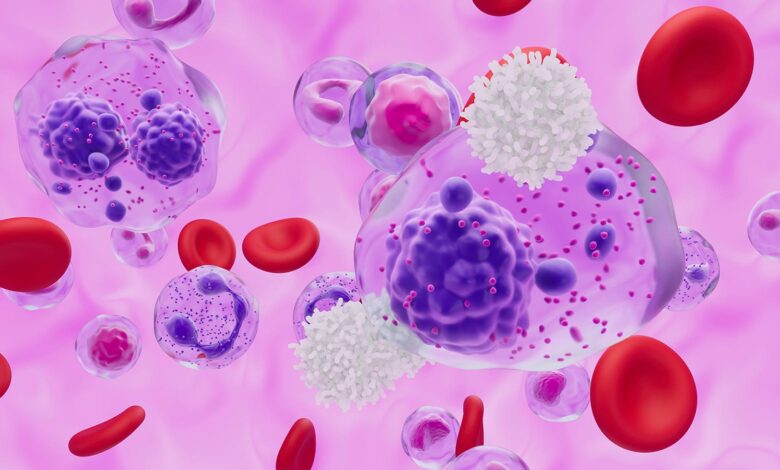Refractory Multiple Myeloma Responsive to Immunotherapy Plus Low-Dose Radiotherapy

—
A third of patients who had received multiple prior lines of therapy responded, small study shows
by
Charles Bankhead,
Senior Editor, MedPage Today
July 10, 2024
A third of patients with relapsed/refractory multiple myeloma responded to pembrolizumab (Keytruda) plus single-fraction radiotherapy (RT), a small clinical study showed.
Results at 3 months showed that seven of 25 evaluable patients responded to the treatment and one patient had stable disease. Two patients had complete responses. Immunologic response (changes in CD8+/CD4+ cells) was associated with clinical response.
No patient had RT-associated grade ≥3 toxicity, and one patient had a grade 3 event attributed to the immune checkpoint inhibitor, reported Mohammad Khan, MD, PhD, of Emory University and Winship Cancer Institute in Atlanta, and co-authors in Lancet Haematology.
“The combination was safe and improved objective responses, abscopal responses, and immunological profiles in patients with relapsed or refractory multiple myeloma who had been heavily pretreated,” the authors stated. “Future trials could investigate the use of combining immune checkpoint inhibitors with radiotherapy as a treatment option for people with relapsed or refractory multiple myeloma or other hematological malignancies.”
“These trials should also include activated CD8+ and CD4+ T cells as potential biomarkers of treatment response,” they added. “Use of radiotherapy, in combination with immunotherapy, might overcome resistance seen in previous lines of therapy.”
The results suggest that anti-PD1 inhibition plus single-fraction RT is active in patients who had not responded to previous therapy, including CAR T-cell therapy, and the radiation “seems to have an abscopal effect, including antigen-presentation enhancement,” according to the author of an accompanying editorial.
“The results from Khan and colleagues suggest that CD8+ and CD4+ T cells proliferate after anti-PD1 and a single fraction 8-Gy radiotherapy and that these proliferating cells have an effector-like phenotype,” noted Kenshi Suzuki, MD, PhD, of the Japanese Red Cross Medical Center in Tokyo. “Concomitant hypofractionated radiotherapy and pembrolizumab was safe, no grade 4 or 5 adverse events were observed, with early indications of response activity. This approach could provide an option for patients with relapsed or refractory multiple myeloma who have few treatment options.”
“Larger, confirmatory global phase III trials are needed to further evaluate the effectiveness of this treatment,” Suzuki added.
A variety of systemic therapies have been used to treat relapsed/refractory myeloma. Single-agent pembrolizumab proved safe but ineffective in a 30-patient trial. Two different trials of pembrolizumab plus chemotherapy showed an unacceptably high rate of serious adverse events, including several treatment-related deaths, Khan and co-authors noted in their introduction.
The role of RT alone in relapsed/refractory myeloma has been limited to palliative care for skeletal events and to control spinal cord compression, the authors continued. The International Lymphoma Radiation Oncology Group guidelines include a single 8-Gy dose of RT as one option for palliative uses.
Little evidence has accumulated regarding the safety and efficacy of RT plus PD-1/L1 inhibition in myeloma. However, human syngeneic-equivalent models of melanoma have shown that RT can increase the immune response of an anti-PD-1 antibody. Extrapolating from the preclinical data, Khan and colleagues postulated that combining RT and an anti-PD1 antibody might change the tumor microenvironment to increase anticancer activity in multiple melanoma.
Investigators evaluated pembrolizumab plus a single 8-Gy dose of RT in patients with heavily pretreated relapsed/refractory multiple myeloma. They enrolled 25 patients with a median age of 62 who had received a median of 5.2 prior lines of therapy, including seven patients who did not respond to CAR T-cell therapy.
The primary endpoint was grade ≥3 toxicity during the first 3 months within the irradiated area. The endpoint was based on preclinical data showing that RT increased CD8+ T-cell infiltration within the irradiated environment. Synergism between PD-1 inhibition and RT theoretically could increase toxicity within the RT field.
Objective response was defined as a change in lesion size by radiographic assessment or International Myeloma Working Group criteria. Abscopal response was defined as radiographic improvement at a non-irradiated distant site.
The results showed that seven patients had objective responses, consisting of three partial responses, two very good partial responses, and two complete responses. One additional patient had stable disease as best response, resulting in a treatment benefit of 32%.
Exploratory analyses included the association between proliferation of CD8+, CD4+, or Foxp3 and clinical response. The analysis included 17 patients with both T-cell and clinical data. The data showed that 12 patients (71%) had a proliferative CD8+ response and nine (53%) had a proliferative CD4+ or Foxp3 response (defined as a 1.5-fold increase in PD1+Ki67+ cells at any time point during treatment).
Seven patients (41%) with T-cell data had a clinical response. Six of the seven had better CD8+ response. In contrast, six of 10 patients with progressive disease had a CD8+ response. Five of the seven patients (72%) with clinical response had CD4+ response, as compared with four of the 10 patients with progressive disease.
-
![author['full_name']](https://clf1.medpagetoday.com/media/images/author/charlesBankhead_188.jpg)
Charles Bankhead is senior editor for oncology and also covers urology, dermatology, and ophthalmology. He joined MedPage Today in 2007. Follow
Disclosures
The study was funded by Merck Sharp & Dohme.
Khan disclosed a relationship with Merck. Co-authors reported multiple relationships with industry.
Suzuki disclosed relationships with Takeda, Ono Pharmaceuticals, Amgen, Sanofi, Novartis, Bristol Myers Squibb, AbbVie, and Janssen.
Primary Source
Lancet Haematology
Source Reference: Khan MK, et al “Pembrolizumab and low-dose, single-fraction radiotherapy for patients with relapsed or refractory multiple myeloma: A prospective, single-center, single-group, open-label phase II pilot trial in the USA” Lancet Haematol 2024; DOI: 10.1016/S2352-3026(24)00105-4.
Secondary Source
Lancet Haematology
Source Reference: Suzuki K “Pembrolizumab plus single-fraction radiotherapy for patients with relapsed or refractory multiple myeloma” Lancet Haematol 2024; DOI: 10.1016/s2352-3026(24)00168-6.



